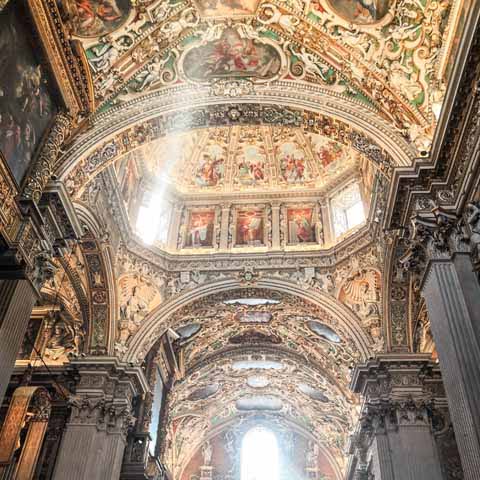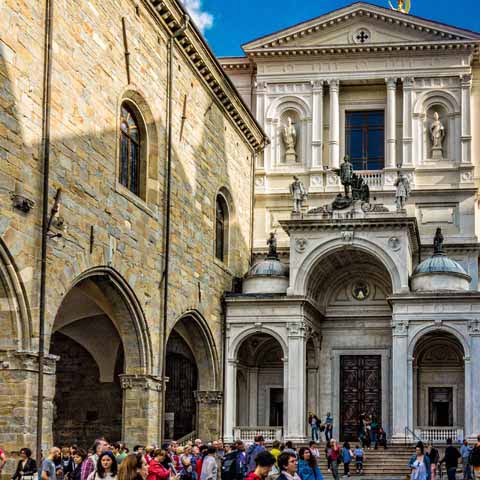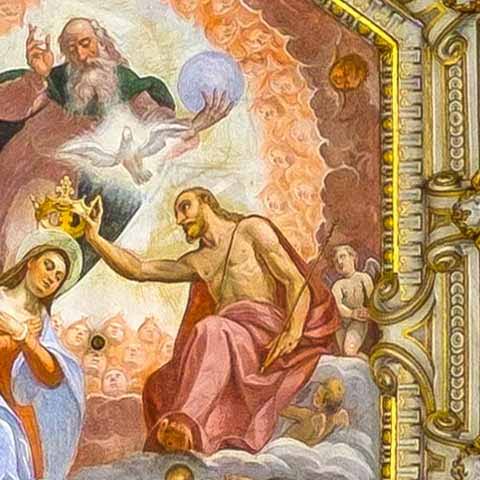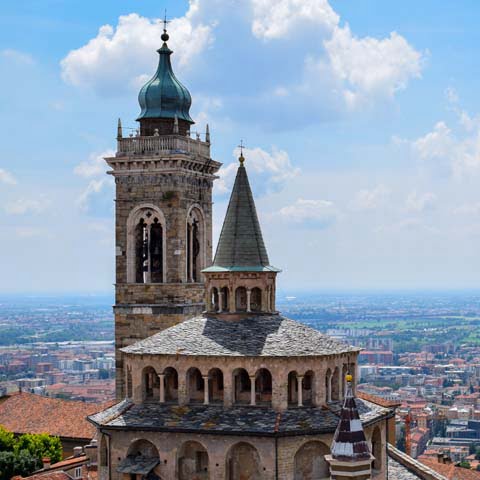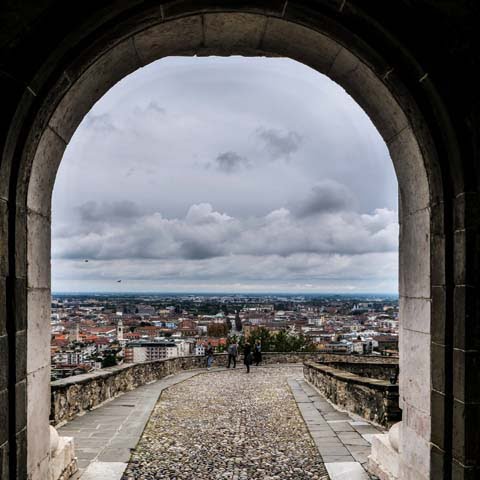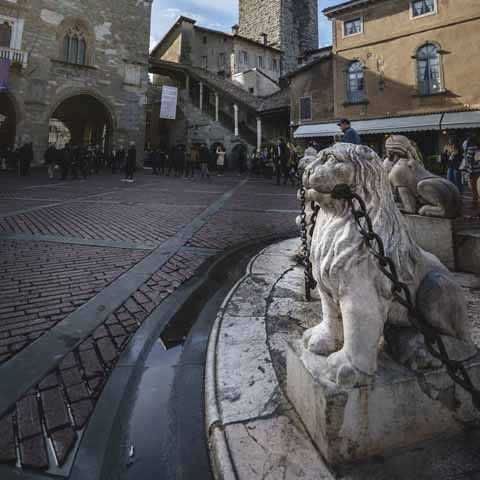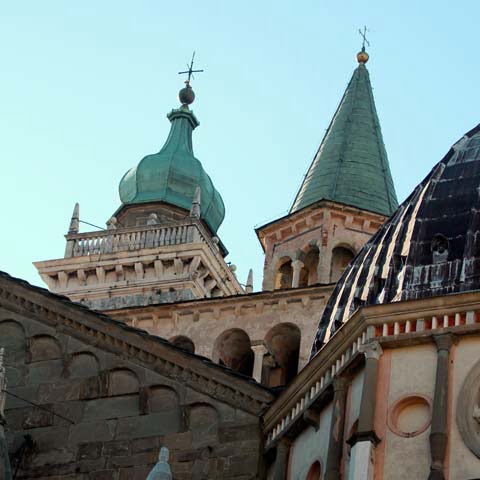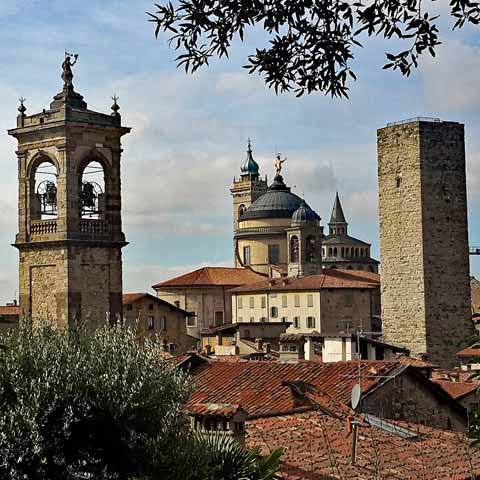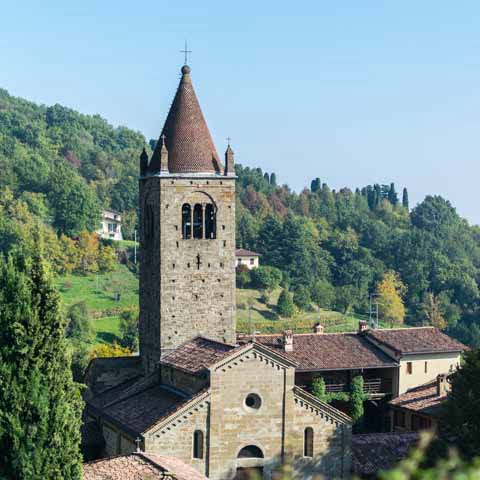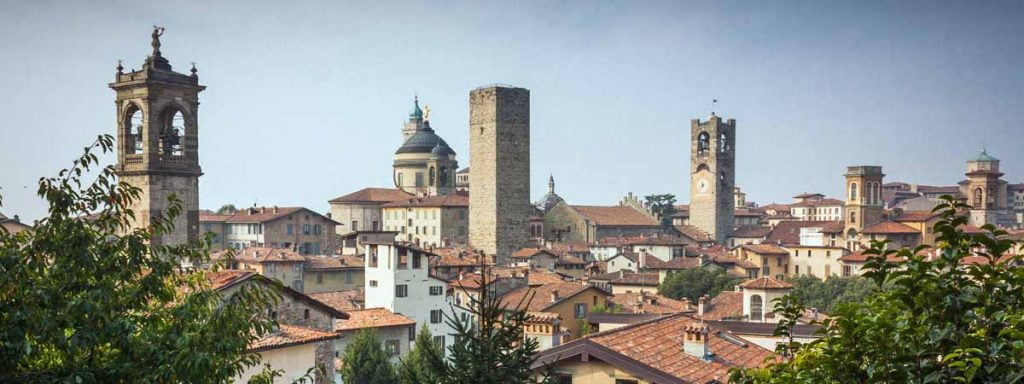Hidden away in Northern Italy, just northeast of Milan is the treasure of the city of Bergamo. Although smaller than the popularly traveled Milan, it is still large in size and is home to a warm small-town community feel as well as rich tradition and culture. Whether you seek to explore the stunning architecture of the renowned Basilica of Santa Maria Maggiore, the art of the Accademia Carrara, or the soothing jazz notes of the annual Bergamo Jazz Festival, this lovely Italian town has something for everyone. Bergamo is every bit as charming as it is enchanting, and it awaits you.
ARCHITECTURE
One of the most prominent and beloved religious institutions in Bergamo is the Basilica of Santa Maria Maggiore. Despite the church’s grand interior and appearance, the basilica came from humble beginnings. Legend has it that the church was built by a group of men who prayed to the Virgin Mary for protection against a twelfth century plague, survived, and then built the church in honor of Mary. The builders spared no expense and constructed a very large and beautiful church that has only been enhanced in the centuries since. Today, visitors will find a wide collection of art within the walls of the basilica, including rich tapestries, stuccos, stunning frescoes, and even wooden marquetry by famed artist Lorenzo Lotto.
Bergamo’s Cathedral, called Duomo di Bergamo by locals, stands in the heart of the city. This fifteenth century church is dedicated to Saint Alexander, whose ashes are said to be ever present in an urn that sits in an altar within the cathedral. The Neoclassical exterior of the church is stately and features clean lines, magnificent columns, and intricate carvings. The Baroque interior is a far grander affair with a light and airy atmosphere. Aside from the historical ties to Saint Alexander of Bergamo, the cathedral is now the seat of the Bishop of Bergamo and is also home to a collection of breathtaking frescoes.
Perhaps one of the most detailed examples of Renaissance architecture in Bergamo is the Cappella Colleoni, or Colleoni Chapel (Old City). With the outstanding design and detail of the fifteenth century chapel’s exterior, most visitors would never guess the structure is a mausoleum dedicated to Bartholomew, Mark, and John the Baptist. The exterior of the building is nothing short of stunning with rose windows, ornate balconies, beautiful arches, grand entryways, and intricate carvings. Although photography is generally not allowed once inside the chapel, the interior is equally impressive and a must see for your visit to Bergamo.
Somewhat different from its larger religious counterparts is the Tempietto di Santa Croce, a circa eleventh century chapel. Possibly one of the most intriguing things about this octagonal-shaped stone structure is that it is often overlooked by locals and visitors because of its plain appearance and the fact that it is largely overshadowed by the neighboring Basilica of Santa Maria Maggiore. Despite the simple exterior of the building, beautiful murals abound within. It is worth noting that the building is sometimes closed to the public, so be sure to check on touring availability before visiting.
Bergamo’s Baptistery, located in the Città Alta’s Piazza Duomo, has a distinct octagonal shape. The number eight is actually featured quite a few times, as the Baptistery also has eight interior bas-reliefs and eight sculptures on the exterior dome. Originally built during the fourteenth century, the Baptistery was actually moved and rebuilt several times during its history. Today the Baptistery features Neo-Gothic architecture and lies in the heart of Bergamo’s Old City.
Also close to the Basilica of Santa Maria is what is commonly referred to as the Old Bishop’s Palace. The palace’s main draw are the dozens of ancient murals and old paintings found within its walls. Although this building which is thought to be built atop an old Roman forum contains great beauty, it is more often than not somewhat deserted, making it a perfect way to enjoy authentic period art without the crowds.
The sixteenth century Venetian walls that stretch almost four miles long were once built to fortify and defend the city in ancient times but are still in excellent condition today. Their architecture is so impressive they have been designated as a United Nations Educational Scientific and Cultural Organization World Heritage Site. If time allows, walk along the top of the high stone walls for a truly unique experience.
ART
Bergamo’s Accademia Carrara is an internationally renowned art gallery with an impressive and extensive collection of period paintings including medieval, Renaissance, and Baroque. Founded in the late eighteenth century by Count Giacomo Carrara, the museum is known for its vast collection of art that typically includes more than fifteen hundred paintings, one hundred sculptures, and many other art mediums. The museum contains works by artists such as Pisanello, Botticelli, Mantegna, and Evaristo Baschenis to name just a few.
Art lovers will also not want to miss the Gallery of Modern and Contemporary Art, referred to as GAMeC. Located across from Accademia Carrara, GAMeC’s collection focuses on contemporary art. Displays here generally include a rotating collection of personal exhibitions of artists from across the globe. The museum is known to hold special events for artists young and old to encourage their love of art.
For additional historic art, head to the Adriano Bernareggi Museum of Sacred Art. Housed in a historic building that dates back to the sixteenth century, the museum showcases the works of art collected by a former Bishop of Bergamo during the twentieth century, Monsignor Adriano Bernareggi. The focus here is on Christian art and its influence on society. Art on display includes works by Lorenzo Lotto, Giovanni Battista Moroni, and more.
The Matris Domini Monastery Museum is renowned for its collection of approximately 20 frescoes. The beautiful frescoes were completed between the thirteenth and fourteenth centuries. A wide variety of religious figures and scenes are depicted in the frescoes including Jesus, Saint Peter, and the Visitation of the Virgin Mary to St. Elizabeth.
LITERATURE
Gasparino Di Pietrobuono was a fourteenth and fifteenth century writer born near Bergamo. Pietrobuono was both a teacher and a writer that was particularly fond of Latin literature. One of his most famous works, Epistolae Gasparini (Gasparinus’ Letters), is thought to have been the first book in France to have been printed and published with Johann Heynlin’s new printing press.
MUSIC
For more than forty years, the Bergamo Jazz Festival has been a staple. During this week-long event, jazz artists from across the globe come together to celebrate this musical genre. The festival is rather large and is considered by many to be one of the most prestigious jazz events in the country.
Legendary nineteenth century composer, Gaetano Donizetti, is both honored and revered in Bergamo. Donizetti was born in the city, and the house in which he was born serves as a museum. Several special Bergamo landmarks were established in honor of the great composer including the Donizetti Museum, which offers a history of his life, and the Basilica of Santa Maria Maggiore which contains his tomb. To this day, Donizetti is perhaps best known for his works of Lucia di Lammermoor and L’elisir d’amore, but he is thought to have written more than seventy different operas over the years.
Named after Gaetano Donizetti, Bergamo’s Donizetti Theater is one of Northern Italy’s leading opera houses. The original structure was completed towards the end of the eighteenth century, but was destroyed by a fire before the turn of the century. The current structure dates back to 1800 and was renamed in Donizetti’s honor in 1897.
CINEMA
Perhaps Bergamo’s most significant contribution to the big screen are the scenes of Director Luca Guadagnino’s 2017 movie Call Me By Your Name that were filmed in the city and in the province of Bergamo’s scenic Serio Waterfalls, which is considered to be the tallest waterfall in Italy.
Other movies either filmed or set in Bergamo include One Night with You (1948), Il cavaliere del sogno (1947), I nostril mariti (1966), La poliziotta (1974), Nessuno è perfetto (1981), and Colpire al cuore (1982).
SCIENCE
Bergamo is home to a branch of the Mario Negri Institute for Pharmacological Research. The non-profit institute has made strides in biomedical research, particularly in the fields of kidney diseases, diabetes, clinical pharmacology, organ transplants, rare diseases, and more.
The city of Bergamo is a vast cultural treasure trove located in the heart of Northern Italy’s Lombardy region. The art museums, historic churches, and ornate palaces offer days worth of exploration to the city’s curious visitors.
Travel Guides
The Lombardy Region of Italy
The Cities of Lombardy, Italy
